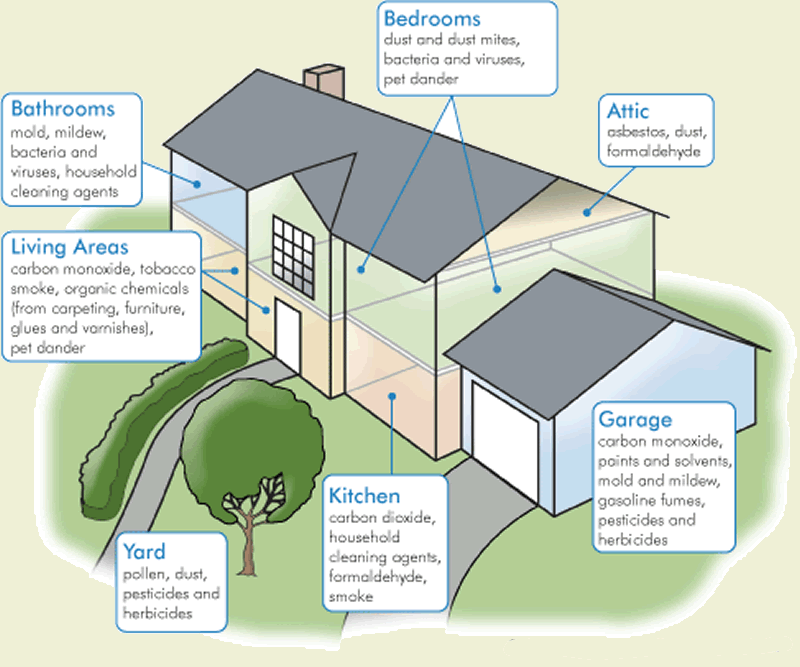
| Summary of Common Indoor Air Pollutants, Health Effects, Sources & Some Methods Of Control | |||
Pollutant |
Sources In The Home |
Health Effects |
Methods Of Pollutant Control |
Formaldehyde Colorless gas with strong odor |
Various construction materials, including particleboard, interior paneling and drapes |
Eyes, nose and throat irritation |
Substitute oriented strandboard (OSB) and exterior-grade plywood for particleboard. Seal particleboards with low-toxicity vapor proof sealers and paint or varnish in cabinets and closets on subflooring. Increase ventilation rates. |
Radon Odorless, colorless radioactive gas |
Soil beneath and around the house foundation |
Believed to be the cause of 5 to 10 percent of all lung cancer. |
Seal floor drains, sumps and all cracks, joints and penetrations through basement walls and slab. Ventilate crawl space tightly and seal subfloor joints and penetrations. Depressurize the gravel bed beneath slab or isolated the basement from the rest of the house and pressurize it with air drawn from the floors above. |
Carbon Monoxide Colorless, odorless gas |
Kerosene heaters, wood-burning appliances, unvented gas appliances, attached garages, blocked chimneys and malfunctioning furnaces |
Nausea, headaches and blue fingernails. Severe poisoning can cause brain damage in fetuses and can be fatal |
Provide outside combustion air feed to the firebox of all wood-burning appliances. Install tight-fitting doors on fireplaces and wood stoves. Vent gas ranges directly to the outside. Provide adequately sized, tempered make-up air for exhaust fans. Use induced-draft or sealed-draft hot water heaters and furnaces. |
Nitrogen Dioxide Has odor when present in large quantities. |
Kerosene heaters and unvented gas appliances |
Lung damage and increased potential for lung disease after long exposure. |
|
Respirable Suspended Particulates Particles suspended in the air that can be inhaled |
Tobacco smoke, wood smoke, unvented gas appliances, kerosene heaters, asbestos construction materials, dust |
Eye, nose and throat irritation, lung cancer, emphysema, heart disease, bronchitis, respiratory infections |
Avoid smoking inside. Ensure wood-burning appliances and flues do not leak. Vent combustion appliances outside. Provide outside combustion air feed to the fireboxes of all wood-burning appliances. Install tight-fitting doors on fireplaces and wood stoves. Increase ventilation rates. Use medium efficiency pleated fabric filters or HEPA filters in the furnace and change them regularly. |
Moisture High humidity |
Ground water entering through the foundation, cleaning, bathing, washing and respiration. |
Causes growth of micro-organisms, increases release of formaldehyde. |
Place a drainage pad of crushed stone beneath the foundation and provide drainage at the foundation's perimeter. Seal beneath the foundation with a polyethylene barrier. Provide adequate ventilation. Vent dryer directly to the outside. |
Organic Solvents |
Household cleaners and solvents in paints and caulking |
Eyes, nose and throat irritation, can affect central nervous system |
Use solvent-based materials in well-ventilatied areas. Substitute water-based paints and caulking for solvent based products. |
